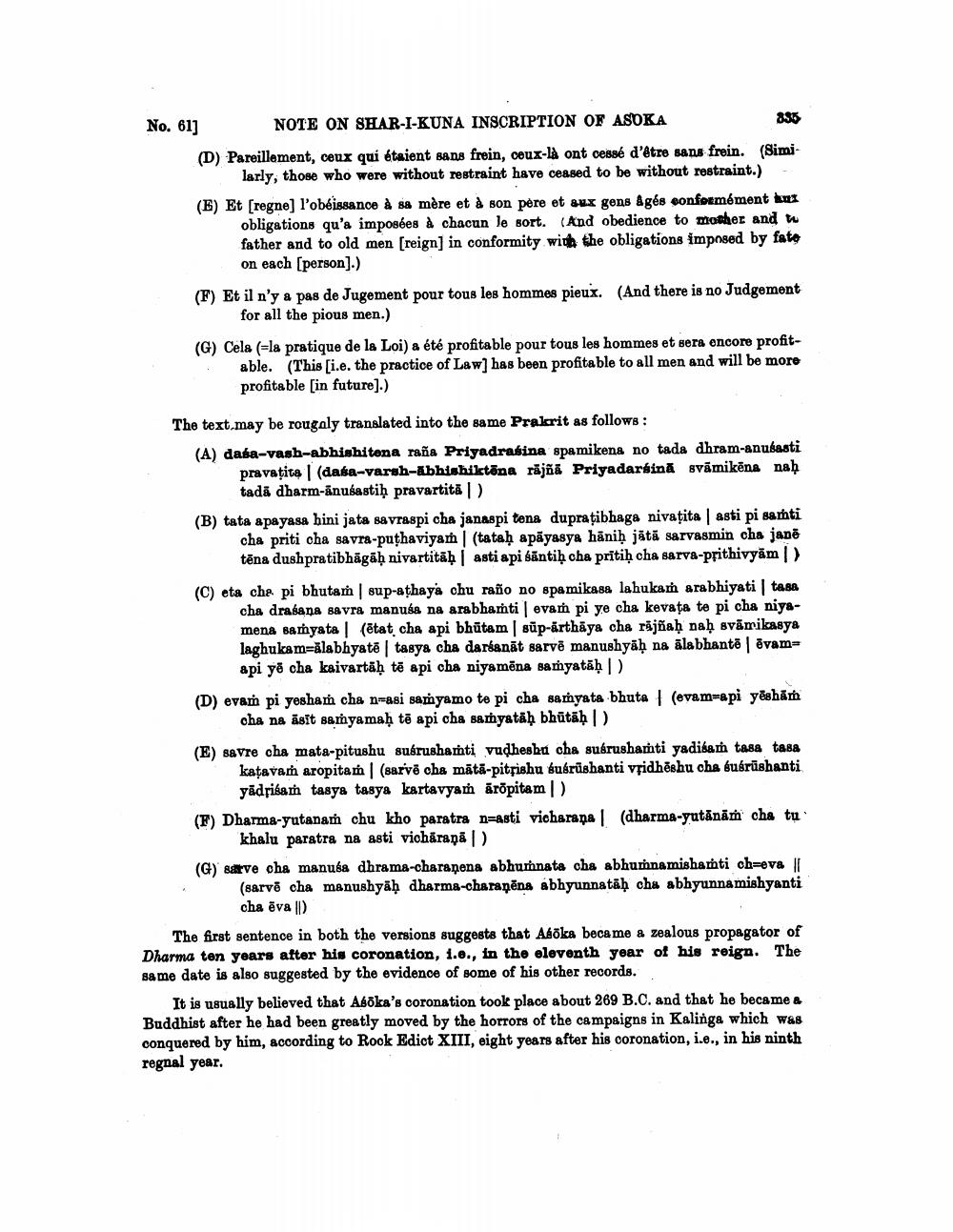________________
836
No. 61] NOTE ON SHAR-I-KUNA INSCRIPTION OF ASOKA (D) Pareillement, ceux qui étaient sans frein, coux-là ont cessé d'être sans frein. (Simi
larly, those who were without restraint have ceased to be without restraint.) - (E) Et [regne) l'obéissance à sa mère et à son père et aux gens &gés eonformément kun
obligations qu'a imposées à chacun le sort. (And obedience to mother and to father and to old men (reign) in conformity with the obligations imposed by fato
on each [person).) (F) Et il n'y a pas de Jugement pour tous les hommes pieux. (And there is no Judgement
for all the pious men.) (G) Cela (=la pratique de la Loi) a été profitable pour tous les hommes et sera encore profit
able. (This [i.e. the practice of Law] has been profitable to all men and will be more profitable (in future].)
The text may be rougaly translated into the same Prakrit as follows: (A) daba-vash-abhishitena raña Priyadrabina spamikena no tada dhram-anusasti
pravatite | (dasa-varsh-abhishiktāna rajña Priyadarsinā svāmikēna naḥ
tadă dharm-anusastiḥ pravartita ) (B) tata apayasa hini jata savraspi cha janaspi tena dupratibhaga nivaţita | asti pi samti
cha priti cha savra-puthaviyam tataḥ apāyasya hāniḥ jätā sarvasmin cha janë tēna dushpratibhāgāḥ nivartitāḥ | asti api sāntiḥ cha prītiḥ cha sarva-prithivyām
(C) eta che pi bhutam | sup-athaya chu raño no spamikasa lahukam arabhiyati tasa
cha drasana savra manusa na arabhamtievam pi ye cha kevata te pi cha niyamena samyata (état cha api bhūtam sūp-arthāya cha räjñaḥ naḥ svārikasya laghukam=ālabhyatē | tasya cha darsanāt sarvē manushyāḥ na ālabhantē ēvam=
api yē cha kaivartāḥ tē api cha niyamēna samyatāḥ). (D) evam pi yesham cha n=asi samyamo te pi cha samyata bhuta | (evam-api yễsham
cha na āsīt samyamaḥ tē api cha samyatāḥ bhūtā)) (E) savre cha mata-pitushu suárushamti vadhesba cha subrushamti yadibam tasa tasa
katavam aropitam (sarvē cha mātā-pitfishu susrüshanti vidhëshu cha busrūshanti
yādsisam tasya tasya kartavyan áropitam ) (F) Dharma-yutanam chu kho paratra n=asti vicharana | (dharma-yutānām cha tu
khalu paratra na asti vichāraņā ) (G) save cha manusa dhrama-charaṇena abhumnata cha abhumnamishati cheeva |
(sarvē cha manushyah dharma-charaņēna abhyunnatah cha abhyunnamishyanti
cha ēva II) The first sentence in both the versions suggests that Aboka boca me & zealous propagator of Dharma ten years after his coronation, 1.e., in the eleventh year of his reign. The same date is also suggested by the evidence of some of his other records.
It is usually believed that Aboka's coronation took place about 269 B.C. and that he became a Buddhist after he had been greatly moved by the horrors of the campaigns in Kalinga which was conquered by him, according to Rook Edict XIII, eight years after his coronation, i.e., in his ninth regnal year.




